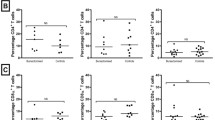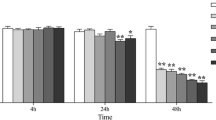Abstract.
Campylobacter jejuni is a significant cause of food-borne diseases in humans. The bacterium is considered a commensal organism in chickens, and it can heavily colonize chickens without causing inflammation. Poultry may be the major reservoir for the human infection in developed countries. Here we show that an outer-membrane protein extract prepared from the bacteria caused apoptosis of chicken lymphocytes detected in vitro with the terminal deoxynucleotidyl transferase-mediated dUTP nick end-labeling assay that preferentially labels individual apoptotic cells. Blood- and spleen-lymphocytes from different-aged chickens displayed a significantly greater percentage of apoptotic cells after culture with the outer-membrane proteins from C. jejuni than controls treated with phosphate-buffered saline, chicken ovalbumin, or outer-membrane proteins prepared from E. coli strain BL21. The C. jejuni extract also produced apoptosis of chicken lymphoblastoid tumor cell lines. Apoptosis was blocked by pretreating the extract with proteinase K or antiserum against outer-membrane proteins. The results suggest that C. jejuni may be capable of achieving immune avoidance in chickens by causing apoptosis of lymphocytes.
Similar content being viewed by others
Author information
Authors and Affiliations
Additional information
Received: 13 October 1998 / Accepted: 27 November 1998
Rights and permissions
About this article
Cite this article
Zhu, J., Meinersmann, R., Hiett, K. et al. Apoptotic Effect of Outer-Membrane Proteins from Campylobacter jejuni on Chicken Lymphocytes. Curr Microbiol 38, 244–249 (1999). https://doi.org/10.1007/PL00006795
Issue Date:
DOI: https://doi.org/10.1007/PL00006795




